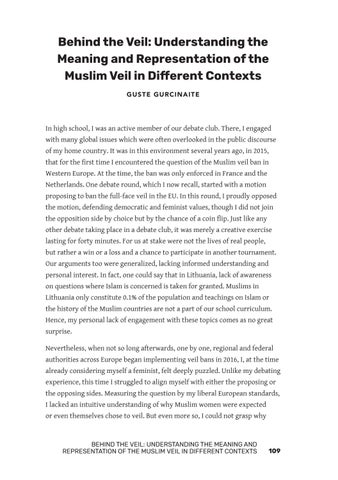Behind the Veil: Understanding the Meaning and Representation of the Muslim Veil in Different Contexts G U STE G U R C I NA I TE
In high school, I was an active member of our debate club. There, I engaged with many global issues which were often overlooked in the public discourse of my home country. It was in this environment several years ago, in 2015, that for the first time I encountered the question of the Muslim veil ban in Western Europe. At the time, the ban was only enforced in France and the Netherlands. One debate round, which I now recall, started with a motion proposing to ban the full-face veil in the EU. In this round, I proudly opposed the motion, defending democratic and feminist values, though I did not join the opposition side by choice but by the chance of a coin flip. Just like any other debate taking place in a debate club, it was merely a creative exercise lasting for forty minutes. For us at stake were not the lives of real people, but rather a win or a loss and a chance to participate in another tournament. Our arguments too were generalized, lacking informed understanding and personal interest. In fact, one could say that in Lithuania, lack of awareness on questions where Islam is concerned is taken for granted. Muslims in Lithuania only constitute 0.1% of the population and teachings on Islam or the history of the Muslim countries are not a part of our school curriculum. Hence, my personal lack of engagement with these topics comes as no great surprise. Nevertheless, when not so long afterwards, one by one, regional and federal authorities across Europe began implementing veil bans in 2016, I, at the time already considering myself a feminist, felt deeply puzzled. Unlike my debating experience, this time I struggled to align myself with either the proposing or the opposing sides. Measuring the question by my liberal European standards, I lacked an intuitive understanding of why Muslim women were expected or even themselves chose to veil. But even more so, I could not grasp why
BEHIND THE VEIL: UNDERSTANDING THE MEANING AND REPRESENTATION OF THE MUSLIM VEIL IN DIFFERENT CONTEXTS
109






